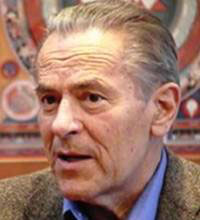The Healing Potential of Transpersonal Coaching
 Healing the causes of emotional and psychosomatic disorders through transpersonal coaching.
Healing the causes of emotional and psychosomatic disorders through transpersonal coaching.
Exploring how it’s possible and how it’s done…
.
This article unpacks and builds on Stanislav Grof’s perspective on how therapeutic applications of a specific category of non-ordinary states of consciousness can have healing and transformative value, especially in relation to emotional and psychosomatic disorders. The article will also cover how Grof’s view of the perinatal stage in our human development can be useful to those interested in conscious parenting, as well as for healing traumatic memories. Comments are made regarding how Grof’s insights and lessons can be put to use in the field of transpersonal coaching.
In his lecture at the Scientific and Medical Network’s 1995 Beyond The Brain conference, titled “The Heuristic and Healing Potential of Non-Ordinary States of Consciousness”, Grof used the term “primal mind” to describe a fundamental level of consciousness that is intrinsic to every human being. Grof suggests that accessing “holotropic states”, a subdivision of non-ordinary states of consciousness, enables access to the primal mind, which in turn reveals levels of awareness that have been reported for ages and across a wide variety of indigenous cultures and practices, such as shamanism, Aboriginal rites of passage, healing rituals and mystical practices. According to Grof (1995), “holotropic” literally means moving toward wholeness, and the experience of holotropic states is what lead Carl Jung to assume the existence of the collective unconscious.
Grof highlights two lessons – first, the heuristic potential or what we can learn from practices that facilitate non-ordinary states of consciousness, and second, the therapeutic applications of such practices. Grof expressed a vision for the future of psychology in his 1995 lecture, which he expands on in his 2000 book, “Psychology of the future”, and incorporates into his latest book, “Healing Our Deepest Wounds: The Holotropic Paradigm Shift” – published in 2012 on Grof’s 81st birthday, where he writes:
I have come to the conclusion that the theoretical concepts and practical approaches developed by transpersonal psychology, a discipline that is trying to integrate spirituality with the new paradigm emerging in Western science, could help alleviate the crisis we are all facing. These observations suggest that radical psychospiritual transformation of humanity is not only possible, but is already underway. The question is only whether it can be sufficiently fast and extensive to reverse the current self-destructive trend of modern humanity (p. 163).
 Born in 1931 in Czechoslovakia, Grof was raised without any religious affiliations. In the 1960s he became a psychiatrist and psychoanalyst. Over time his intellectual interests that stemmed from the insights of psychoanalysis began to clash with his disappointment about its practical effectiveness. It took a long time to achieve very little! This prompted Grof to explore other approaches. He describes how his initial interest in consciousness research was elevated through experiences with LSD, and how this lead to his lifetime interest in non-ordinary states of consciousness. Grof became involved in testing LSD for a pharmaceutical company, as a way of enabling psychiatrists to understand psychotic states and to assist treatment. He began to explore what could be learned about the nature of consciousness and what the therapeutic potential of these non-ordinary states or “episodes of powerful experiences” might be. Later on his use of psychedelic substances as a means of achieving non-ordinary states was replaced by Holotropic Breathwork, a method that Grof co-created with his wife (Christina Grof) in the 1970s and 1980s involving accelerated breathing, evocative music and bodywork to reach deep levels of transpersonal awareness. Some methods used in transpersonal coaching today (for example: the open awareness technique) are also designed to induce holotropic states, yet they do so within the framework of a coaching dialogue where the initial intention is typically to help a client resolve a personal crisis or to establish greater meaning or direction in their life.
Born in 1931 in Czechoslovakia, Grof was raised without any religious affiliations. In the 1960s he became a psychiatrist and psychoanalyst. Over time his intellectual interests that stemmed from the insights of psychoanalysis began to clash with his disappointment about its practical effectiveness. It took a long time to achieve very little! This prompted Grof to explore other approaches. He describes how his initial interest in consciousness research was elevated through experiences with LSD, and how this lead to his lifetime interest in non-ordinary states of consciousness. Grof became involved in testing LSD for a pharmaceutical company, as a way of enabling psychiatrists to understand psychotic states and to assist treatment. He began to explore what could be learned about the nature of consciousness and what the therapeutic potential of these non-ordinary states or “episodes of powerful experiences” might be. Later on his use of psychedelic substances as a means of achieving non-ordinary states was replaced by Holotropic Breathwork, a method that Grof co-created with his wife (Christina Grof) in the 1970s and 1980s involving accelerated breathing, evocative music and bodywork to reach deep levels of transpersonal awareness. Some methods used in transpersonal coaching today (for example: the open awareness technique) are also designed to induce holotropic states, yet they do so within the framework of a coaching dialogue where the initial intention is typically to help a client resolve a personal crisis or to establish greater meaning or direction in their life.
Based on his work with thousands of individuals over five decades, Grof (2003) suggests that stressful and traumatic events during life are not the causes of emotional and psychosomatic disorders, they are merely the triggers that cause the emergence of psychological material from deeper levels of the unconscious. According to Grof (2000, p. 75) psychological problems develop as a result of the reinforcing influence of traumatic events in our postnatal history, which in turn have causal links to perinatal, prenatal and transpersonal origins. Grof (2000) argues that a newborn’s birth experience (the perinatal phase) profoundly influences that individual’s emotional and social development, and therefore this has important implications for the future of our society. Grof points out that the amount of emotional and physical stress involved in childbirth clearly surpasses that of any trauma later in life and is an event of immense psychospiritual importance (2000 p. 31). Grof’s studies have revealed that the memory of birth is recorded in detail down to cellular level and it therefore profoundly affects psychological development (Grof 2000 p. 31). For this reason Grof sees value in regressing to the perinatal stage for the purpose of healing and personal development. Grof’s methods of facilitating transcendence and spiritual growth also transit the perinatal, as he views this domain as a gateway to the transpersonal realm.
Ken Wilber criticises Grof’s emphasis on the perinatal, which he sees as simplistic. Birth may well be traumatic and may be an entry into transpersonal experience but it is only part of the story, according to Wilber (1997). The difference of opinion involves what is referred to as the pre/trans fallacy:
The point is simply that, for example, since prerational and transrational are both, in their own ways, nonrational, then they appear quite similar or even identical to the untutored eye. Once this confusion occurs – the confusion of “pre” and “trans” – then one of two things inevitably happens: the transrational realms are reduced to prepersonal status, or the prerational realms are elevated to transrational glory (Wilber, 1997 p. 181).
Wilber maintains that Grof confuses the pre-personal and the trans-personal. Grof counters this through stating that, although he agrees with Wilber in principle, Wilber’s model is too absolutist and linear in his thinking about the multidimensional world of the psyche (Grof, 1985). In addition it could be considered that Grof has worked with thousands of individuals in the many years of his involvement in transpersonal psychology and that his claims about the transcendental nature of peoples’ experiences are derived from many observations,- hardly an untutored eye. Wilber’s views are largely based on the wisdom traditions combined with his own practice and theories. Grof is certainly not alone when it comes to exploring the healing potential of addressing perinatal experiences. In addition to Grof’s findings, the value of better understanding the extent of prenatal and perinatal trauma in order to address their influences on mental health and emotional wellbeing through life has long been suggested by those in the field of prenatal and perinatal psychology (http://birthpsychology.com/journals; cited in Axness, 2012, p. 93).
Dr. Michael Odent also supports Grof’s claims by suggesting that the quality of life in the womb, during birth and post-birth lays the foundation for a loving and altruistic relationship with fellow humans, or conversely for a mistrusting and aggressive attitude toward society (1995, cited in Grof 2000 p. 112). Dr. Dan Siegel (2012, p. 11) confirms that our earliest experiences shape the narrative of our lives. Awareness of the importance of prenatal and perinatal care dates back to ancient China and India, with Caraka, an Indian embryologist writing in 1000 BC that psychological factors in the mother may cause mental disturbance in the foetus (cited in Axness 2012, p. 93). While Odent (2010) provides evidence for the fact that our level of mental, emotional and physical health in adulthood is significantly influenced by the attitudes of our mother during pregnancy and birth, Grof goes one step further by suggesting that there are even more complex subtleties at play which contribute to why we are the way we are.
An example given by Grof (1995) is that the cause of claustrophobia could be tracked back to an incident in childhood, but if explored further it will most likely have deeper roots that may stem from factors relating to birth or pre-birth, and looking further still one may discover that the potential for claustrophobia to manifest may even come from a particular experience in a past life. Full healing will therefore involve interventions that address all the causal domains and triggers that influence the existence of the condition. Further examples given by Grof (1995) indicate that traumas associated with prenatal and perinatal related experiences are of significant influence on the physio/psycho/spiritual development of each individual.
 Therapeutic interventions that are designed to heal early life (or even past life) traumas are not within the scope of traditional coaching models, however, the transpersonal coaching approach can include the facilitation of processes that enable clients to transcend their subjective experience of time, and can therefore address traumatic memories. This is done for the purpose of helping clients to become consciously aware of the original causes of their current issue, in order to learn from those past or symbolic experiences, and then give them a new and constructive meaning. The following step in the process is to discharge the energy of the trauma so that it no longer has any hindering effect in the client’s present life experience. In such a way, transpersonal coaching can include regression techniques, although such sessions need not involve eye closure, breathwork or any form of ritualistic procedure. Regression for the purpose of healing can be facilitated in the context of a coaching dialogue that utilises attention shifting methods (for example: open awareness) in combination with appropriate (ethical and relevant to the client) use of healing metaphors.
Therapeutic interventions that are designed to heal early life (or even past life) traumas are not within the scope of traditional coaching models, however, the transpersonal coaching approach can include the facilitation of processes that enable clients to transcend their subjective experience of time, and can therefore address traumatic memories. This is done for the purpose of helping clients to become consciously aware of the original causes of their current issue, in order to learn from those past or symbolic experiences, and then give them a new and constructive meaning. The following step in the process is to discharge the energy of the trauma so that it no longer has any hindering effect in the client’s present life experience. In such a way, transpersonal coaching can include regression techniques, although such sessions need not involve eye closure, breathwork or any form of ritualistic procedure. Regression for the purpose of healing can be facilitated in the context of a coaching dialogue that utilises attention shifting methods (for example: open awareness) in combination with appropriate (ethical and relevant to the client) use of healing metaphors.
Grof realised that the Newtonian/Cartesian dualism that dominates the West has no place for spirituality. He refers to the anthropologist Michael Harner, pointing out that we have adopted an ethnocentric view of mental health, by seeing our culture as superior to any others. He says in his 1995 lecture:
We have pathologised all non-ordinary states with the exception of dreams. When they are not repetitive and associated with anxiety you are allowed to dream and be considered normal. And with this kind of attitude, we have really, if you think about it, pathologised the entire spiritual history of humanity.
Lukoff (2007) suggests that the worldview of contemporary society is bound to be challenged as an increasing amount of people report visionary spiritual experiences through engaging in spiritual practices. “Spiritual emergence” is the phrase that Grof uses to describe as a natural process of growth and unfolding, while “spiritual emergency” he describes as an overwhelming, often unwelcome or frightening onslaught of contents from the unconscious mind which produces a disruption of normal functioning. “Spiritual emergency” is often misunderstood and seen as a form of psychosis (Grof & Grof, 1997).
A well-documented disruption in normal functioning is that of Near-Death Experiences (NDEs). NDEs include transpersonal phenomena entering someone’s experience during the short time that they are dead, or on the brink of death, or in a coma. Once brought back to normal consciousness (most often through emergency medical intervention), individuals who have experienced NDEs often report being deeply affected by their experience of an ‘after-life’ during the time that they were considered devoid of consciousness. Having personally been on the verge of death on three separate occasions, I can most certainly confirm the life-changing effect of such experiences, which amplified my perceptions about myself and everything in existence – described in the article: What I learned while dying in an ambulance.
If NDEs represent non-ordinary states associated with events after this life, then events experienced before this life present another type of non-ordinary state. Grof refers to ‘past life experiences’ in the accounts of his clients and workshop participants which seem to be corroborated by historical details (Grof & Bennett, 1993 p. 122). One of the ways of understanding past life experiences, suggested by Grof and Laszlo (2009) is Erwin Laszlo’s Akashic Field,- a sub-quantum field, in which everything that has ever happened remains permanently holographically recorded. Rupert Sheldrake’s ‘formative causation’ hypothesis offers yet another explanation for the experience of past life phenomena, through suggesting that we resonate with that which is most like ourselves, thus we may tune in by morphic resonance to someone who lived in the past (Sheldrake, 1988). Formative causation might also help us to comprehend the experience of group consciousness to which Grof refers in his 1995 lecture, as this may suggest an attunement with the morphic field of a particular group or culture.
Grof’s methods of accessing the transpersonal realm have been seen as controversial but his insights into the domain beyond our personal egos and the value of accessing it are important lessons for our Western society and are as valid today as ever before. Grof sees the transpersonal movement as having the potential to produce a revolution in understanding akin to the effect of quantum mechanics on classical physics.
 Perhaps one of the most valuable aspects that Grof’s work has to offer society is confirmation of the importance of approaching pregnancy and birth mindfully. With awareness of parental influence as well as the trauma that is associated with birth, future parents should be encouraged to take steps toward treating pregnancy and birth as a precious and delicate transition into a new life that will be effected by the way in which the pregnancy and birth are treated. For parents who in hindsight are concerned about the effects of negative pregnancy or birth experiences on themselves or on their children, there is still hope. Tom Robbins (1990) reminded us that “it’s never too late to have a happy childhood”, and on that note the unwanted effects of prenatal and perinatal trauma can be healed. First of all, how would one identify if one’s current mental, emotional or social problem stems from negative programming in the womb or during birth? Transpersonal coaching involves establishing the root causes of the client’s issue. If it is identified that healing in the prenatal or perinatal domain is required, then transpersonal coaching will include that along with strategies to resolve postnatal factors and other determinants of the client’s issue. Furthermore, the holistic nature of transpersonal coaching processes can also include identifying and, if necessary, resolving other factors that influence the client’s issue, for example: physiological, psychological, interpersonal and spiritual phenomena.
Perhaps one of the most valuable aspects that Grof’s work has to offer society is confirmation of the importance of approaching pregnancy and birth mindfully. With awareness of parental influence as well as the trauma that is associated with birth, future parents should be encouraged to take steps toward treating pregnancy and birth as a precious and delicate transition into a new life that will be effected by the way in which the pregnancy and birth are treated. For parents who in hindsight are concerned about the effects of negative pregnancy or birth experiences on themselves or on their children, there is still hope. Tom Robbins (1990) reminded us that “it’s never too late to have a happy childhood”, and on that note the unwanted effects of prenatal and perinatal trauma can be healed. First of all, how would one identify if one’s current mental, emotional or social problem stems from negative programming in the womb or during birth? Transpersonal coaching involves establishing the root causes of the client’s issue. If it is identified that healing in the prenatal or perinatal domain is required, then transpersonal coaching will include that along with strategies to resolve postnatal factors and other determinants of the client’s issue. Furthermore, the holistic nature of transpersonal coaching processes can also include identifying and, if necessary, resolving other factors that influence the client’s issue, for example: physiological, psychological, interpersonal and spiritual phenomena.
Considering the multi-dimensional extent of human consciousness, we can now make more responsible choices with regards to how we will pave the way for more fulfilment in our own lives and for the collective, as well as for future generations. A final word on the value of non-ordinary states is included here from Grof’s 1985 book:
The deeply felt unity with the rest of the world tends to open the way to a genuine appreciation of diversity and a tolerance of differences. Sexual, racial, cultural and other prejudices appear absurd and childish in the light of the vastly expanded world view and understanding of reality that includes the transcendental dimension (p. 432)
.
Written by Jevon Dangeli – Transpersonal Coach, MSc Transpersonal Psychology
.
> Live Transpersonal Coach training
.
> Online Transpersonal Coach training
.
Related articles:
- Introduction to Transpersonal Coaching
- The Transpersonal Coach Model
- Transformation in Transpersonal Coaching
- Transpersonal Psychology – New Perspectives
- Mindfulness, Bodyfulness and Open Awareness
- Open Awareness (a transpersonal coaching skill)
- The mindful remedy for stress and burnout
- Bouncing back from burnout
.
References
Axness, M (2012). Parenting for Peace: raising the next generation of peacemakers. Boulder, CO : Sentient Publication, pp. 93/94
Clarke, I., (2000). Madness and Mysticism : Clarifying the Mystery. Scientific and Medical Network. The Network Review, 72. Retrieved July 6 2013 from the World Wide Web https://www.scimednet.org/madness-and-mysticism-clarifying-the-mystery-2/
Grof, S. (1985). Beyond the brain – birth, death and transcendence is psychotherapy. State University of New York. SUNY Series in Transpersonal and Humanistic Psychology.
Grof, S. (1995). The Heuristic and Healing Potential of Non-Ordinary States of Consciousness. The Scientific and Medical Network, audio recording of presentation. Retrieved January 16, 2013, from the World Wide Web: https://www.scimednet.org/assets/Private/video/SMN-V041995Beyond-the-BrainGrofTart320x240.avi
Grof, S. (2000). Psychology of the future. New York: State University of New York Press, p. 75
Grof, S. (2003). Implications of modern consciousness research for psychology: Holotropic experiences and their healing and heuristic potential,The Humanistic Psychologist, Vol. 31, Issue 2-3, pp. 50-85
Grof, S. (2012). Healing our deepest wounds: the holotropic paradigm shift. Newcastle, WA: Stream of Experience Productions.
Grof, S. and Bennett, H.Z. (1993). The Holotropic Mind: The Three Levels Of Consciousness and How They Shape Our Lives. New York NY : Harper Collins
Grof, C., and Grof, S. (1997). The Stormy Search for Self: A Guide to Personal Growth through Transformational Crisis. Los Angeles. Tarcher
Grof, S. Laszlo, E. (2009). Evidence for the Akashic Field from Modern Consciousness Research. In E. Laszlo Ed. The Akashic Experience: Science and the Cosmic Memory Field pp. 193–211. Rochester, Vt: Inner Traditions
Lukoff, D. (2007). Visionary Spiritual Experiences. Southern Medical Journal, 100, No 6, 635 – 641.
Odent, M. (1995). Prevention of Violence or Genesis of Love? Which Perspective? Presentation at the 14. International Transpersonal Conference in Santa Clara, California.
Odent, M (2010). The Two-Edged Mind: Placebo and Nocebo Responses. The Scientific and Medical Network, audio recording of presentation. Retrieved January 16, 2013, from the World Wide Web: https://www.scimednet.org/assets/Private/Audio/BodyBeyond2010/BB2010Odent.MP3
Robbins, T. (1990). Still life with woodpecker. New York: Bantam Books.
Sheldrake R. (1988). The Presence of the Past, Vermont: Park Street Press
Siegel, D. (2007). The Mindful Brain: Reflection and Attunement in the Cultivation of Well-Being. New York :W.W. Norton.
Wilber K. (1997). Eye to Eye: The Quest For A New Paradigm, Boston: Shambhala. p. 181.
